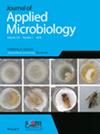Elucidating the bacterial inactivation mechanism by argon cold atmospheric pressure plasma jet through spectroscopic and imaging techniques.
IF 3.2
3区 生物学
Q2 BIOTECHNOLOGY & APPLIED MICROBIOLOGY
引用次数: 0
Abstract
AIMS This study aims to assess the potential bacterial inactivation pathway triggered by argon (Ar) cold atmospheric pressure plasma jet (CAPJ) discharge using spectroscopic and imaging techniques. METHODS AND RESULTS Electrical and reactive species of the Ar CAPJ discharge was characterized. The chemical composition and morphology of bacteria pre- and post-CAPJ exposure were assessed using Fourier transform infrared (FTIR), Raman micro-spectroscopy, and transmission electron microscopy (TEM). A greater than 6 log reduction of E. coli and S. aureus was achieved within 60 and 120 s of CAPJ exposure, respectively. Extremely low D- values (< 20 s) were recorded for both the isolates. The alterations in the FTIR spectra and Raman micro-spectra signals of post-CAPJ exposed bacteria revealed the degree of destruction at the molecular level, such as lipid peroxidation, protein oxidation, bond breakages, etc. Further, TEM images of exposed bacteria indicated the incurred damages on cell morphology by CAPJ reactive species. Also, the inactivation process varied for both isolates, as evidenced by the correlation between the inactivation curve and FTIR spectra. It was observed that the identified gas-phase reactive species, such as Ar I, O I, OH•, NO+, OH+, NO2-, NO3-, etc. played a significant role in bacterial inactivation. CONCLUSIONS This study clearly demonstrated the effect of CAPJ exposure on bacterial cell morphology and molecular composition, illuminating potential bacterial inactivation mechanisms.通过光谱和成像技术阐明氩冷大气压等离子体射流的细菌灭活机制。
目的本研究旨在利用光谱和成像技术评估氩气(Ar)冷大气压等离子体射流(CAPJ)放电引发的潜在细菌灭活途径。使用傅立叶变换红外光谱(FTIR)、拉曼显微光谱和透射电子显微镜(TEM)评估了细菌在接触 CAPJ 前后的化学成分和形态。在 CAPJ 暴露 60 秒和 120 秒内,大肠杆菌和金黄色葡萄球菌分别减少了 6 个对数值以上。两种分离物的 D 值都极低(< 20 秒)。CAPJ 暴露后细菌的傅立叶变换红外光谱和拉曼微光谱信号的变化显示了分子水平的破坏程度,如脂质过氧化、蛋白质氧化、键断裂等。此外,暴露细菌的 TEM 图像显示了 CAPJ 活性物种对细胞形态造成的破坏。此外,两种分离菌的灭活过程各不相同,灭活曲线与傅立叶变换红外光谱之间的相关性也证明了这一点。据观察,已确定的气相反应物种,如 Ar I、O I、OH-、NO+、OH+、NO2-、NO3- 等在细菌灭活过程中发挥了重要作用。
本文章由计算机程序翻译,如有差异,请以英文原文为准。
求助全文
约1分钟内获得全文
求助全文
来源期刊

Journal of Applied Microbiology
生物-生物工程与应用微生物
CiteScore
7.30
自引率
2.50%
发文量
427
审稿时长
2.7 months
期刊介绍:
Journal of & Letters in Applied Microbiology are two of the flagship research journals of the Society for Applied Microbiology (SfAM). For more than 75 years they have been publishing top quality research and reviews in the broad field of applied microbiology. The journals are provided to all SfAM members as well as having a global online readership totalling more than 500,000 downloads per year in more than 200 countries. Submitting authors can expect fast decision and publication times, averaging 33 days to first decision and 34 days from acceptance to online publication. There are no page charges.
 求助内容:
求助内容: 应助结果提醒方式:
应助结果提醒方式:


